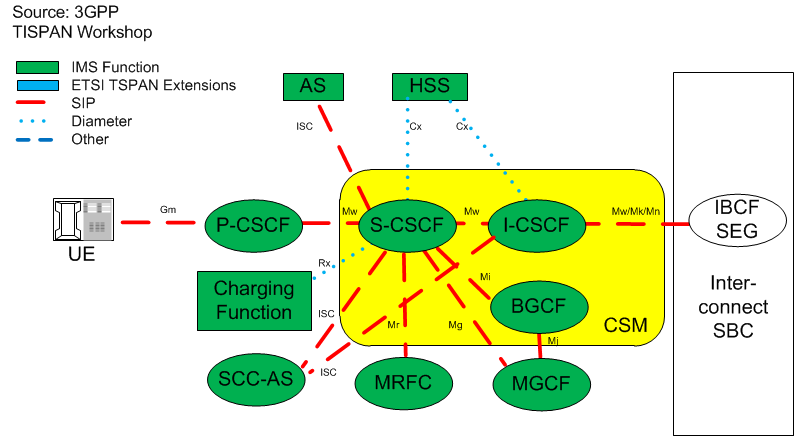Oracle Communications Core Session Manager and IMS
The ETSI TISPAN NGN defines several subsystems that make up the NGN architecture. The model for the target NGN architecture is depicted below. The Oracle Communications Core Session Manager is designed to function as an integrated:
- Interrogating-Call Session Control Function (I-CSCF)
- Serving-Call Session Control Function (S-CSCF)
Deployments typically include the Oracle SBC acting as P-CSCF and the Oracle CSM acting as I-CSCF and S-CSCF.
The functions performed by the Oracle Communications Core Session Manager are best understood as functions of standard IMS elements. The diagram below depicts the mapping of these functions across an IMS architecture.

High level definitions of these functions include:
- I-CSCF—IMS passes traffic to the I-CSCF if the target S-CSCF is unknown.
- S-CSCF—Interaction with the Home Subscriber Server (HSS) determines whether and how to provide service to the endpoint.
- BGCF—The breakout gateway control function provides signaling transit to network domains external to the IMS.
Refer to 3GPP specifications for complete element definitions and explanations of the functions they can or must perform.
As I-CSCF, the Oracle Communications Core Session Manager complies with 3GPP standards to perform the interrogating function and locate the proper S-CSCF for a given session.
As S-CSCF, the Oracle Communications Core Session Manager complies with 3GPP standards and Oracle Communications Core Session Manager to manage sessions. It interacts with the HSS to determine whether any given registration can reside locally, or be managed by another S-CSCF device. It also interacts with the HSS and other infrastructure components to provide applicable services within the context of a given session.